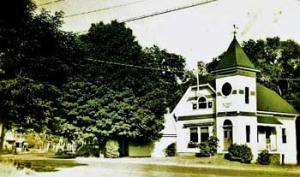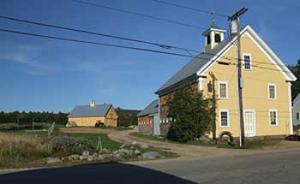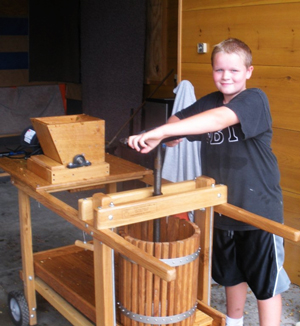Brief History of Tamworth
 The history of Tamworth officially began with the granting of a charter from George the Third of England to the town in the name of Benning Wentworth in 1766. Settlers ventured slowly north into the towering forest that was broken only by the Indians’ trail along the Bearcamp and occasional grassy “intervals.” They burned and chopped the great trees, built the first homesteads, and planted the first crops.
The history of Tamworth officially began with the granting of a charter from George the Third of England to the town in the name of Benning Wentworth in 1766. Settlers ventured slowly north into the towering forest that was broken only by the Indians’ trail along the Bearcamp and occasional grassy “intervals.” They burned and chopped the great trees, built the first homesteads, and planted the first crops.
By 1790 there were 47 heads of families in Tamworth; 126 by 1800. Among them were names still familiar today: Ames, Gilman, Bryant, Mason, Berry, Roberts, Nickerson, Hayford, Durrell, Remick, Boyden and Wiggen. Parson Samuel Hidden was ordained here in 1792 and led the town for nearly fifty of its formative years. The meeting house and one-room school house were built; sheep grazed the hillsides; every farmer grew corn, wheat and rye; grist mills flourished on the streams.
The hardy people of Tamworth, sustained, like their contemporaries, by strong religious faith, came through the smallpox epidemic of 1813; the “cold years” and famines of 1815, ’16, and ’17; the “siege of the wolves” on Great Hill in 1820; and the year 1827, when it snowed in every month.
The remnants of the Pequaket and Ossipee peoples, branches of the Abenaki, who still lived in the region, were primarily peaceful in their relations to the earliest settlers, as counseled by their great Pennacook chief Passaconaway. But the fragility of the understanding between the two cultures comes down to us in the poignant legend of Chief Chocorua.
After Chocorua’s father Paugus was killed on Lovell’s Pond, Passaconaway’s son Wonalancet led his remaining tribesmen away to the town of St. Francis on the St. Lawrence River.
The native people are remembered in local place names, some of them bestowed by the poet Lucy Larcom and others during the 1870s and ‘80s.
 As soon as the first farms were established, saw mills, shingle mills, and turning mills proliferated in every part of town. Houses, churches, and schools were built close to them, forming the villages of South Tamworth, Whittier Chocorua, Wonalancet and Tamworth. Industry and inventiveness flourished. Loggers, blacksmiths, millers, shoemakers, storekeepers, furniture- and barrel-makers plied their trades. Nearly all were farmers too. The women’s prodigious skills in spinning, weaving, sewing, baking, and preserving are hard to imagine today.
As soon as the first farms were established, saw mills, shingle mills, and turning mills proliferated in every part of town. Houses, churches, and schools were built close to them, forming the villages of South Tamworth, Whittier Chocorua, Wonalancet and Tamworth. Industry and inventiveness flourished. Loggers, blacksmiths, millers, shoemakers, storekeepers, furniture- and barrel-makers plied their trades. Nearly all were farmers too. The women’s prodigious skills in spinning, weaving, sewing, baking, and preserving are hard to imagine today.
In the 1850s, Tamworth’s population peaked at 1,766 souls, a level not to be reached again until the early 1980s. The coming of the railroad, which provided easier access to the more fertile land to the west, and the end of the Civil War, an experience that had given many New Hampshire soldiers a look at what lay beyond the rocky soils of their home state, contributed to the waning of the local agricultural era.
Tamworth and surrounding towns were to find their true economic future in the beauty of the spectacular mountains and valleys, lakes and rivers, fields and forests that make up the landscape. To supply the growing number of visitors with comfortable shelter and food, the farmers and their wives opened their homes to summer boarders. Carriages collected visitors at the Mt. Whittier station, and drove them with their luggage (and often servants as well) to local inns and boarding houses, where many stayed for extended periods of time, enjoying walking trails, scenic vistas, and homegrown country food.
Entertainment abounded. On July 4th, 1882, the Willow Inn in Tamworth Village had about 100 guests. Its guest book for the period includes glass blowers, comic vocalists, minstrel shows, a ventriloquist, a cornet band, a “Grand Opera,” and even Christine Nilsson, the great Swedish singer – with the majority of the performances occurring at the Town House. There were horse races on the Depot Road, visiting baseball teams, and a traveling circus, whose elephants refused to cross the Swift River Bridge and, instead, had to be led through the water!
As knowledge of the beauty of the area spread, the influx of visitors gradually encompassed not only the summer season, but also autumn for its incomparably vivid foliage, and winter for the sports activities – skiing, skating, snowshoeing, and, eventually, snowmobiling. Inns, cabins, and hotels sprang up, and the purchase of second homes was widespread.
Many of the newcomers, some quite well-known outside Tamworth, originally came as tourists to enjoy the scenic beauty and outdoor activities and later chose to stay on as second home owners or permanent residents. Of these, perhaps the most famous was President Grover Cleveland, whose son Francis Cleveland founded The Barnstormers Theatre with his wife Alice in 1931. It is today the oldest professional summer theater in the country.
 As the town grew, countless townspeople left their mark on the quality of life in Tamworth. Added to the oldest family names were new ones like Brett, Currier, Evans, Vittum and Welch; Later still, Bolles and Bowditch, James and Runnells, Finley, Read, Steele, Bowles, Cannon, Harkness, McGrew, and many, many others, some of which we find on the roads and buildings, trails and parks we all encounter every day. In fact, quite a few present day Tamworth residents proudly carry the names of their ancestors who have called Tamworth home throughout its history.
As the town grew, countless townspeople left their mark on the quality of life in Tamworth. Added to the oldest family names were new ones like Brett, Currier, Evans, Vittum and Welch; Later still, Bolles and Bowditch, James and Runnells, Finley, Read, Steele, Bowles, Cannon, Harkness, McGrew, and many, many others, some of which we find on the roads and buildings, trails and parks we all encounter every day. In fact, quite a few present day Tamworth residents proudly carry the names of their ancestors who have called Tamworth home throughout its history.
Perhaps the person most influential in Tamworth history was Parson Samuel Hidden. He came to Tamworth freshly graduated from Dartmouth College in 1792. He was ordained at Ordination Rock and became the first settled minister in town. His interests were broad and, besides spiritual leadership, he brought cultural benefits to this small town. He taught music and started a choir, supervised existing schools and opened new ones, and started the Tamworth Social Library (the fourth in the entire state).
With this cultural start in the 1700s, it is no surprise that Tamworth is still known today for its artistic, literary and religious organizations. The town currently boasts two public libraries, an art gallery, the Arts Council of Tamworth, the Tamworth Historical Society, the Tamworth Foundation, The Barnstormers, six churches, and many resident authors, poets and artists.
Today’s Tamworth citizens, like their predecessors, pursue an astonishing variety of occupations and livelihoods, from the small-scale farming and logging familiar to earlier residents, to all manner of service and construction industries, educational endeavors, and long-distance electronic businesses. Yankee inventiveness thrives, and the mix of year-round and part-time residents with many talents and interests provides a vitality unusual in a town of this size.
Written by Jean Ulitz and Amy Berrier, with grateful acknowledgement to Marjory Gane Harkness and the wealth of historical information included in her book, The Tamworth Narrative.

